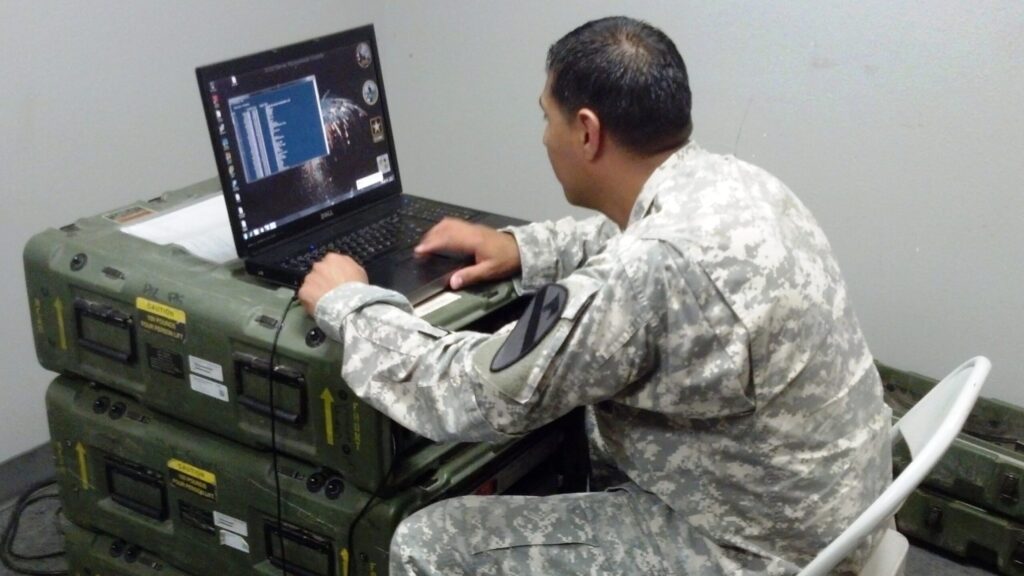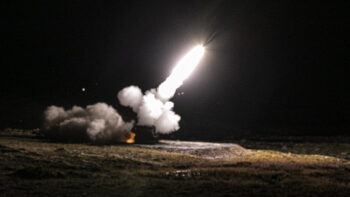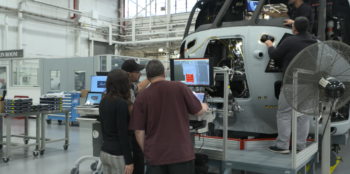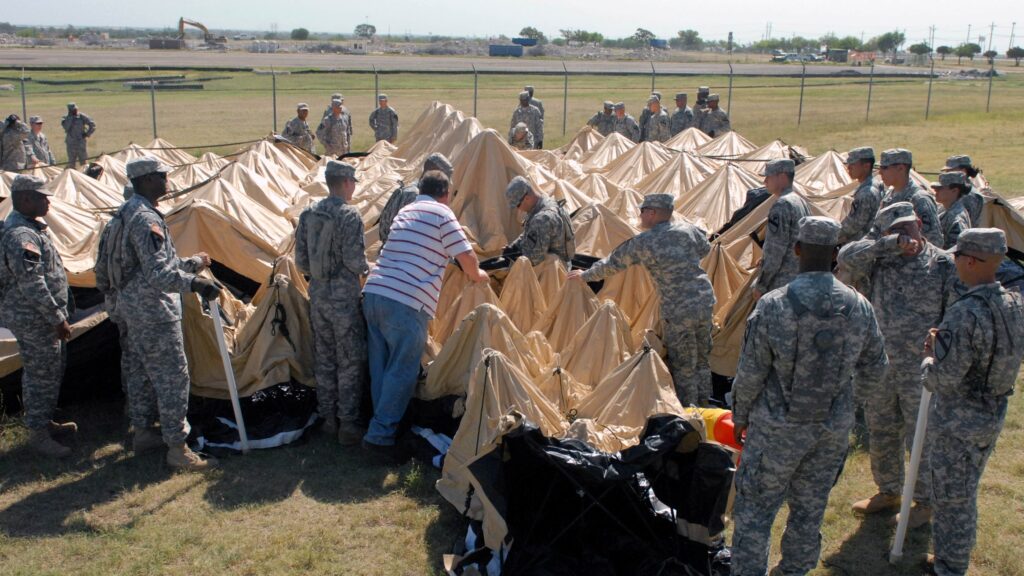
1st Cavalry soldiers set up the main tent for a brigade Tactical Operations Center in a 2010 exercise. (Army photo)
On tomorrow’s battlefield, there’s no safe place for ammo dumps or command posts. Drones will buzz constantly overhead, AI-powered algorithms searching for any sign of life — movement, body heat, wireless signals — that they can target for precision strike. So how can commanders and their staffs survive this new threat, when their very function requires communication?
Ditch that smartphone. Hide in a basement. Turn off every radio you can. Use electronic warfare sensors to scan your own troops for detectable transmissions and shut them off. Offload every function you can to higher headquarters further out of range, transmitting only essential data through an encrypted cloud.
Break up big staffs, like the 200-plus personnel in a divisional Main Command Post, into half a dozen smaller “sub-nodes,” each hiding in a different building or hastily dug bunker, communicating with each other not over Wi-Fi or tactical radio but over ruggedized fiber optic cables a quarter-mile (400 meters) long, unspooled by soldiers through the shelling-shattered windows and rubbled streets.
And every few hours, one of the sub-nodes takes its turn to shut down for a few hours and moved a few hundred yards — never too far for those fiber cables — so that, within a day, the entire formation has relocated, slithering undetected across the battlefield like an amoeba.
RELATED: Army 2030: Disperse or die, network and live
That’s the prescription from the US Army’s Combined Arms Center at Fort Leavenworth, Kansas, helmed by Lt. Gen. Milford Beagle, a South Carolinian who’s served everywhere from Afghanistan and Iraq to South Korea.
“This is something I think all armies are going to wrestle with,” Beagle told Breaking Defense. “The US Army certainly has.”
“It is a transparent battlefield,” added Brig. Gen. Jason Slider, who was Beagle’s director of “mission command” until being seconded to the French Army, part of a longstanding officer exchange program. “You will always be under some type of enemy observation, so deception, decoys, and… improved command and control on the move will be very important…. We have concepts written out, there’s experimentation ongoing – [e.g.] AFC Project Convergence. We’re figuring out what works, what doesn’t work. We ‘re keeping our eye on what technology is in the pipeline.”
The good news is that while new gear can help, it doesn’t take a high-tech revolution to develop useful countermeasures to ubiquitous surveillance and precision targeting, the generals and other Combined Arms Center experts say. They can do a lot with just new tactics, organizational tweaks, and some creative use of terrain and technology that’s widely available, like stringing those fiber optic cables between basement hideouts.
“We can better protect ourselves, reduce risk, even with the technologies that are emerging out there currently,” Beagle said.
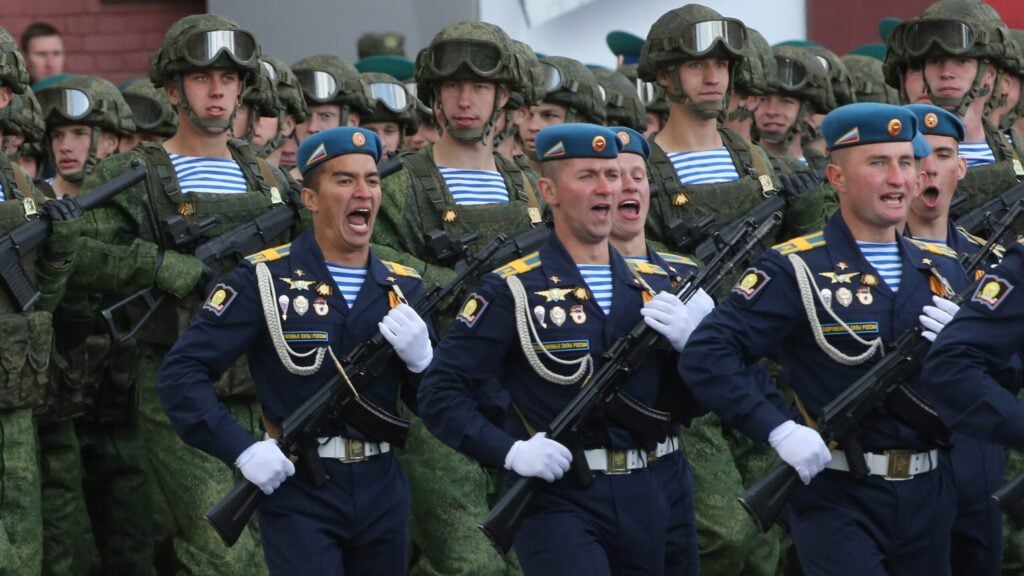
Russian soldiers look sharp in rigidly rehearsed parades but struggle to improvise on the battlefield. (Photo by Contributor/Getty Images)
Learning Deadly Lessons From Russia’s Disasters
Earlier this year, Beagle, Slider, and a third Army officer, Lt. Col. Matthew Arrol, co-authored an article, ominously titled “The Graveyard of Command Posts,” in which they outlined key lessons that US ground forces should learn from the heavy losses the Russian officer corps has taken in Ukraine.
It may be comforting for American commanders to blame Moscow’s military mishaps on incompetence and say they could never happen to them. Indeed, Beagle and Slider told us in the interview, some of the Russian army’s problems are the result of its overcentralized institutional culture, in which senior commanders must move forward to micromanage overwhelmed subordinates who are routinely punished for showing initiative. At least some of these Russian generals were hit by precision strikes because they were talking on easily traceable civilian cellphones.
The US has struggled with similar self-owns — as when deployed troops using fitness apps gave away the location and even exact layout of secret bases in Syria. But the American culture of initiative and improvisation at all ranks “gives us a bit of an off-ramp,” Slider said, because subordinates can take action without constantly going on the radio to check in. US junior officers are briefed on the overall vision for each operation and trained to take “disciplined initiative” to achieve their “commander’s intent” without waiting for new instructions when things change.
“If all of it were to go south in terms of our ability to communicate,” Beagle said, “then it’s all about understanding intent and developing that at echelons so subordinate commanders and soldiers clearly understand, if I can only transmit once [or] they’re severed completely, then you can operate given that intent and within the spirit of that intent.”
On the flipside, however, America’s bigger defense budget and love for technology means that US command posts are even more lavishly endowed with radio-wave-emitting gadgetry than their Russian counterparts. The US Army is also still struggling to break a generation of bad habits acquired in Afghanistan and Iraq.
“The size, the complexity of our command posts is linked to the past couple decades of fighting a counterinsurgency,” “We had those luxuries and ability to do it.”
Going On A Data Diet
Against guerrilla adversaries with no long range weapons and only a handful of drones, the US could build up huge, static Forward Operating Bases with air-conditioned command posts where officers could watch live, full-color, full-motion video (FMV) from drones. But that requires big buildings, high bandwidth, and tremendous emissions of both radio waves and heat (electronics and generators to power them run hot). All of that is easy prey for drone-equipped artillery units like Russia’s — or China’s. So those supersized command posts need to slim down, which includes going on a diet when it comes to data.
“What is it we really need?” Beagle asked. “The ultimate goal at the end of the day is to ensure that the commander has the information that he or she needs [to] understand what’s going on, decide what to do about it, tell someone to do something, [and] keep track of the battle… Everything that does not support that is extraneous.”
RELATED: Don’t share all that data, Army CDO says
The Army’s doing a doctrinal scrub of data requirements at every echelon of the command hierarchy, Slider added, updating what are called Mission Essential Task Lists and deciding the “minimum essential products” for each level from “corps to platoon.”
After two decades of emphasis on village-by-village counterinsurgency by robustly self-sufficient Brigade Combat Teams, which comprise about 4,000 soldiers commanded by a colonel, the Army believes higher headquarters will play a larger role in large-scale wars against Russia or China, so it’s shifting and centralizing many functions, from artillery support to network tech, up to division HQs or even corps.
The goal is not to bloat up the division and corps command posts. Indeed, the Army’s acquisition arm is fielding a new Command Post Computing Environment that consolidates multiple pieces of bulky, specialized hardware — separate “tactical servers” for intelligence, artillery, logistics, and so on — into a single machine running the different functions as software apps. It’s also testing what’s called Command Post Integrated Infrastructure, which replaces traditional CPs housed in tents with mobile command trucks (“expando vans”) that can unfold their sides to accommodate staff, then fold up and drive away in minutes when danger looms.
RELATED: Enough ‘one trick ponies’: Marine special ops specialists want industry help to fuse tech
Future mobile command posts should be in armored vehicles, Beagle and Slider warn, to survive the shrapnel from no-warning strikes. And at the smallest, most forward units, “battalion and below,” Slider said, the goal is to put everything a commander needs on a single ruggedized laptop with the ability to “reach back” through secure communications to get additional data from a cloud computing center safely out of enemy artillery range.
“The cloud is very exciting,” Beagle said, “because … I don’t need to bring all the sever stacks and servers and everything and the power to generate it.” But, he acknowledges, you won’t always have remote access to that cloud server in a battlefield wracked by jamming, hacking, and physical destruction of relays. Rather, he said, at times commanders may decide the risk of detection outweighs the benefit of communication and deliberately turn off some of all of their transmitters, just as submariners sometimes rig for silent running or fighter pilots turn off their radars.
“We’re going to have to go through that culture shift of, you may not have access to all that information,” Beagle said. “[And] if you lose all connectivity, then where’s your backup?… Everything that you do digitally, you need to have a way or practice where you can replicate it in an analog sense, [e.g.] your flat map with an alcohol marker.”
“I definitely don’t want anybody in the audience to think that we’re trying to force our formations to fight blind,” he emphasized. “We’ll fight [equally] with a lot of information, a lot of access, or with very little.”
Aloha: Fixes ongoing, then Army’s new watercraft prototype is Hawaii bound for testing
“Everything that we can knock off that list we will do in the archipelago…because that allows us to do the tests in the environment that the vessel will operate in ultimately,” said Maj. Gen. Jered Helwig.
















